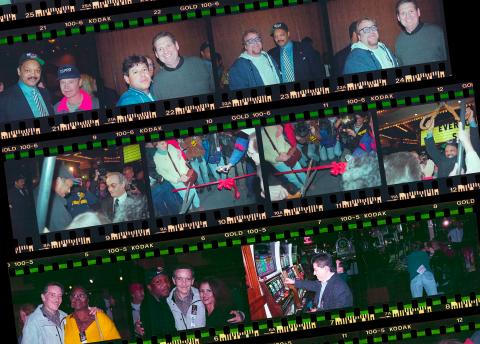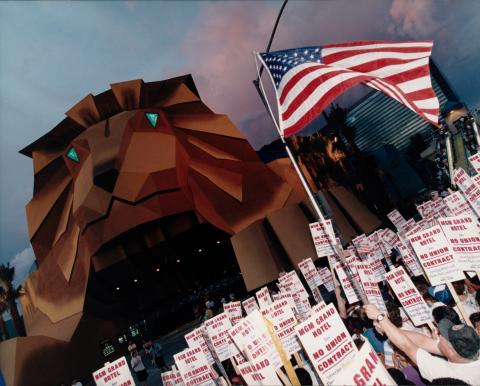
Photographs of Frontier Victory rally , Culinary Union, Las Vegas (Nev.), 1998 January 31. Culinary Workers Union Local 226 Las Vegas, Nevada Photograph Collection (PH:00382)
In one photograph a diverse group of union workers hold up a banner together that boldly declares, “Whatever it takes. As long as it takes.” In another, Rev. Jesse Jackson holds his fist in the air during a labor union rally on the Strip. And in a series of negatives, the moment is captured when one of the longest labor strikes in American history finally ends, with jubilant workers embracing each other and applauding. These are just a few among the thousands of images that can be found within the Culinary Workers Union, Local 226 Photograph Collection, now available online.

Photograph of Jesse Jackson rally, Culinary Union, Las Vegas (Nev.), 1990s, Culinary Workers Union Local 226 Las Vegas, Nevada Photograph Collection (PH:00382)
Since spring 2016, a team of student workers and library staff have been hard at work preparing the physical materials, designing metadata fields, digitizing and uploading thousands of photographs, negatives, and slides to the free and publicly available Special Collections and Archives Portal. Ranging from the 1950s to 2006, these materials document the labor union’s work through images of parades, meetings, and demonstrations, including the historic Frontier Strike of the 1990s that lasted for six years, four months and 10 days.
The work to make this collection available online in its entirety wouldn’t have been possible without the use of new technology acquired in the Digital Collections department, a department in UNLV Libraries Special Collections and Archives. The Digital Transitions Phase One Rapid Capture System is the center of the UNLV University Libraries digitization lab and the core of Digital Collections’ new approach to mass-digitization projects. The rapid-capture system, built specifically for cultural heritage institutions like UNLV University Libraries, captures digital reproductions of virtually anything from photographic film to delicate manuscript collections.

UNLV University Libraries student worked Benhor "Ben" Dimalibot works on the Culinary Union Collection using the Digital Transitions Phase One rapid capture system in the UNLV Libraries Digitization Lab.
With its versatile nature, Head of Digital Collections Cory Lampert says the Digital Transitions System has been key in helping the group move towards a large-scale approach to digitization that is more professional and sophisticated.
“It became very clear that we needed to get something that was designed for libraries, archives, and museums and was optimized for efficiency in production.”
The numbers speak for themselves. Prior to the Culinary Union project, Digital Collections averaged roughly 5,000 new digital objects added to the collections during a typical one-year grant project. That number is now dwarfed by the more than 31,000 items that have been digitized from the Culinary Union project alone, making it one of the largest collections Digital Collections has ever launched.
Aaron Mayes, who has worked with UNLV since 2003, and with Special Collections and Archives for the past year and a half as Curator for Visual Materials, came on board just as the rapid capture system was being implemented. Mayes has seen the benefits first-hand.
“The Culinary Union project was a beast unlike anything that Digital Collections had ever done before,” Mayes said. “Having the ability to finish it all within a reasonable time was only attainable with the Phase One. Working on a flatbed scanner would have meant dozens and dozens of people working many years.”
Lampert agrees, noting that an entire generation of people could have missed out on this piece of history, had slower digitization methods been used.
“Looking back, it really hit me for the first time that something that previously could have sat on a shelf for a decade is now going to be immediately available to the people that lived the history.”
Take the 106 babies born to Culinary Union members during the Frontier Strike, who are now young adults. Their early childhood memories are an important part of Southern Nevada history as well as the greater American labor movement. Not only is their collection easily accessible to family members far away and down the road, but also to a larger audience, making for a universal experience.
Having this ability opens up so many options to Digital Collections,” Mayes shared of the group now having a wider breadth and scope for future projects. “They no longer have time constraints that stifle what collections they want to complete. They can manage multiple large tasks, and think big when it comes to taking on new projects.”


(Top) Photograph of Frontier Victory rally, Culinary Union, Las Vegas (Nev.), 1998 January 31. (Bottom) Photograph of Downtown march on Fremont Street, Culinary Union, Las Vegas (Nev.), 1994 August 10. Culinary Workers Union Local 226 Las Vegas, Nevada Photograph Collection (PH:00382)
The rapid-capture system (and associated software tools) have aided in various digital projects like the Las Vegas Commission City Minutes, and the Southern Nevada Jewish Heritage Project. With this new outlook, work on more expansive collections and projects is underway. One such new project is a large-scale project to digitize 20,000 images from UNLV’s entertainment collections and then share lessons learned via a grant-funded training workshop set for spring of 2018. Its purpose will be to educate and train other organizations across Nevada on more efficient digitization tools and techniques. Inspired by what they have learned, Digital Collections intends to give instruction on building capacity for collections, creating workflows tailored for larger projects, finding better ways to assess staffing and equipment needs, and providing tips on making collections more visible.
In addition to the new technology, Lampert says effective collaboration was a necessity in completing these larger projects. Senior journalism major and Digital Collections student assistant Cindi Mercado echoed Lampert’s sentiment on collaboration, sharing that teamwork among co-workers made the job experience more valuable.
“Most of my past jobs have been monotonous and there’s no ultimate goal to be achieved. In this job, knowing that you are able to complete something and for everyone to see, that’s really rewarding.”

Photographs of MGM Grand rally, Culinary Union, Las Vegas (Nev.), 1994 May 26. Culinary Workers Union Local 226 Las Vegas, Nevada Photograph Collection (PH:00382)
Looking onward, Digital Collections intends to continue using the Digital Transitions Phase One Rapid Capture System to add collections at a faster pace. Another responsibility will be to ensure that once online, the collections are useful and accessible in their large quantities. With the expectation that all things will be digital Lampert suggests other institutions embrace this truth and seek new ways to allow history and technology to converge.
“I think as a profession we need to accept that fact. We can start making a plan so different communities are getting what they need and collections are making a greater impact, sooner.”
Jasmin Bryant is an undergraduate journalism major at UNLV and works in the Digital Collections Department assisting with the Neon Survey project.


